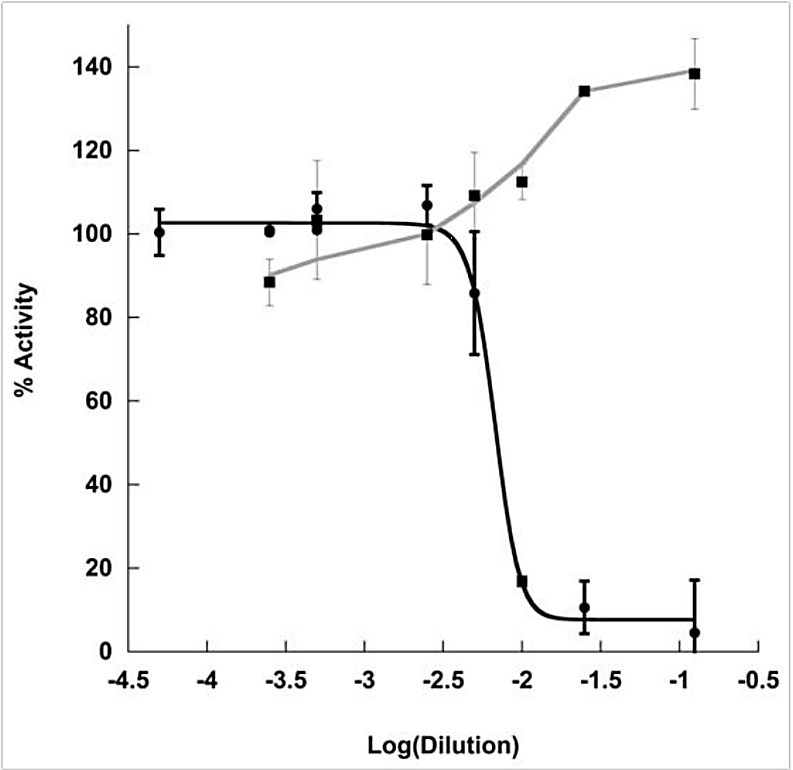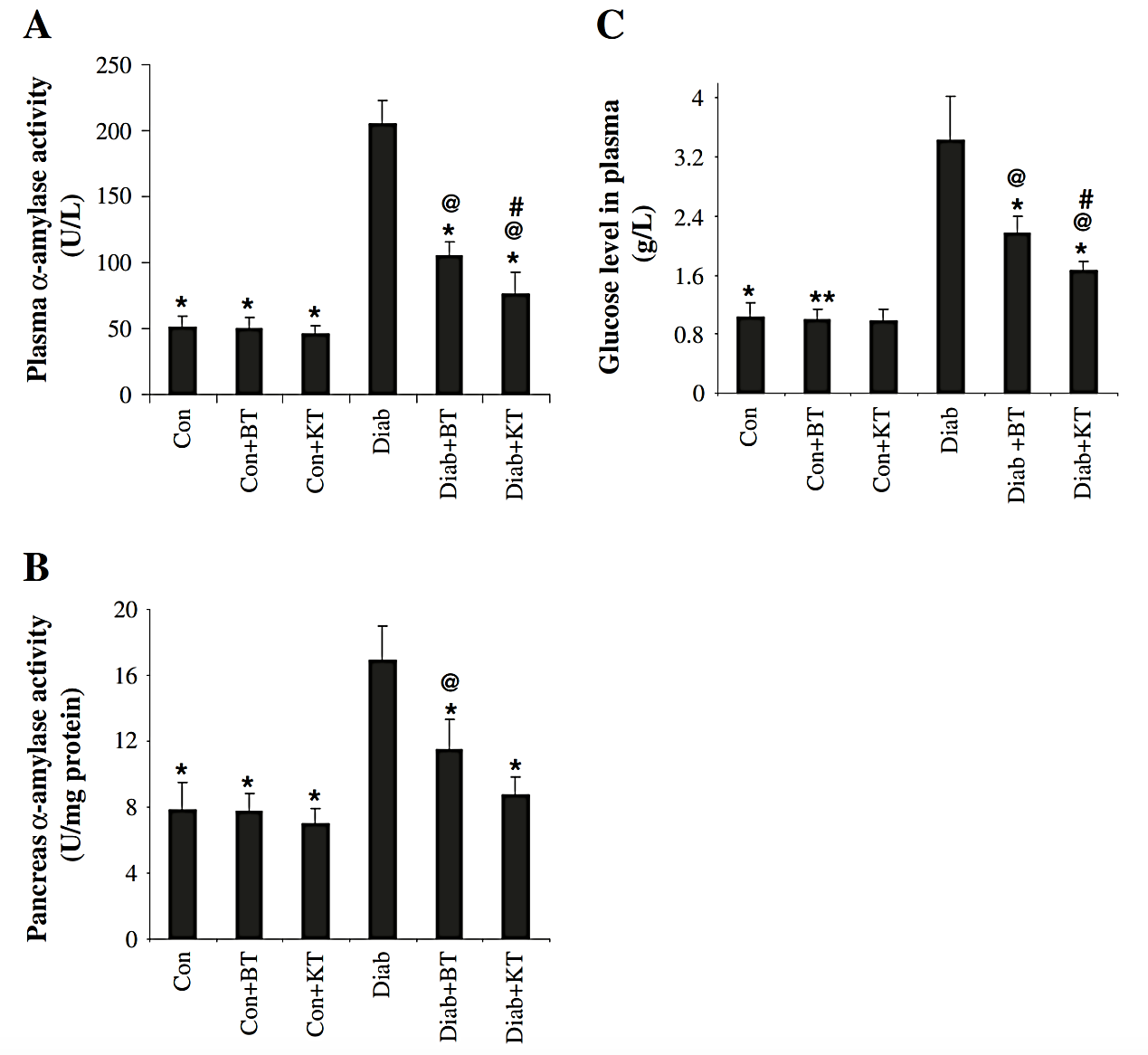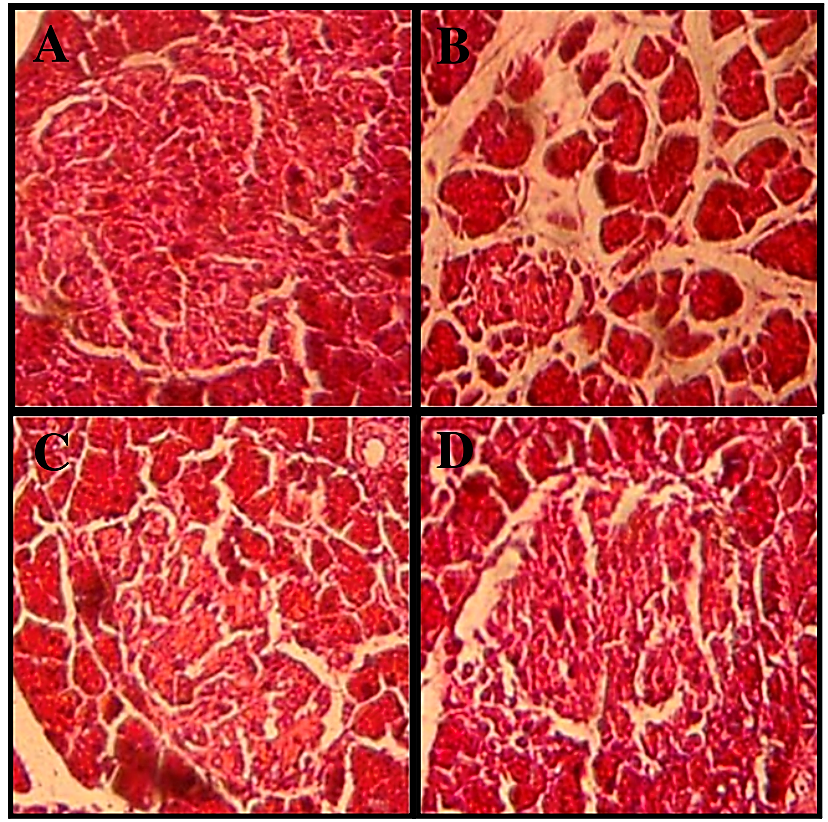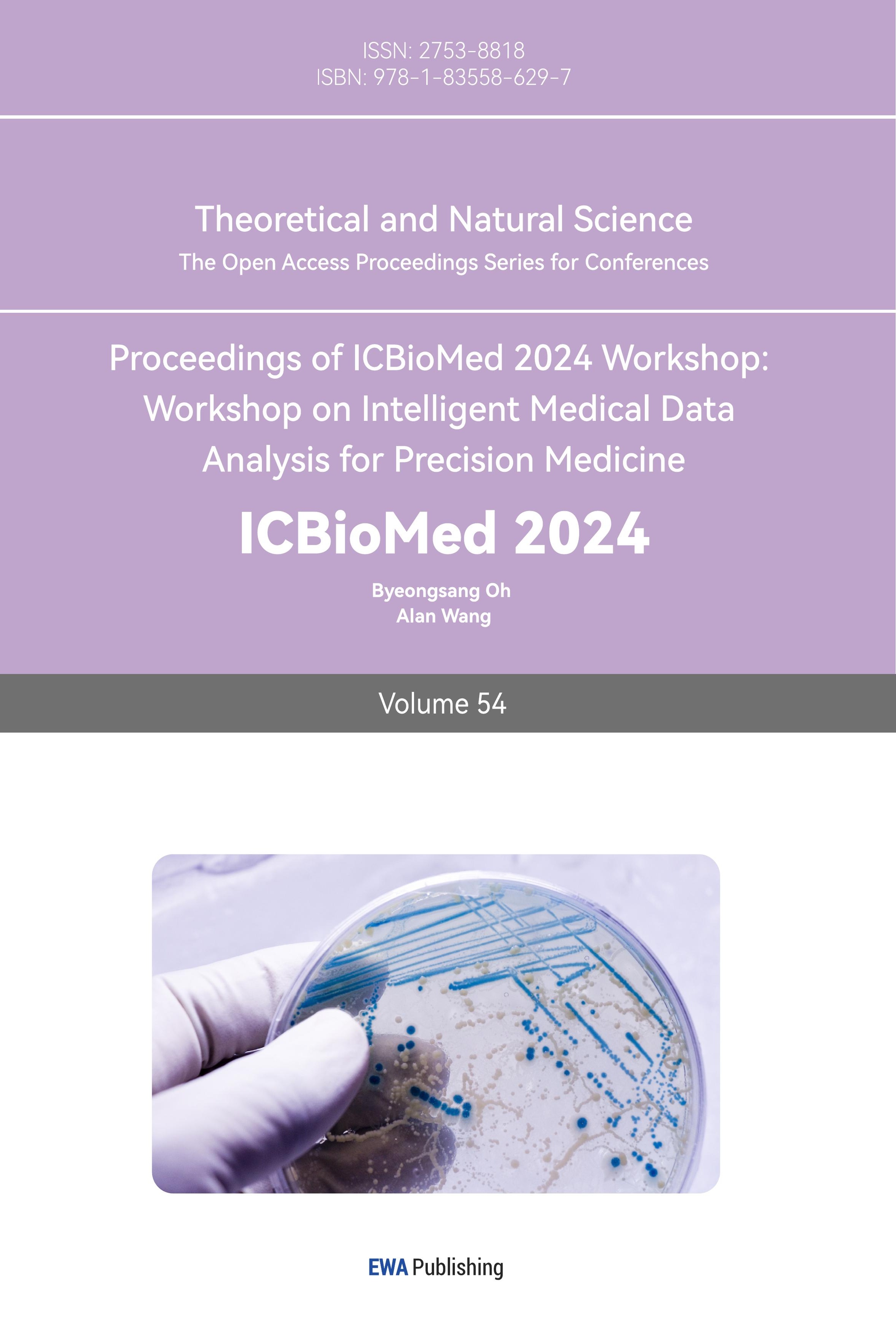1. Introduction
Diabetes is a chronic disease characterized by high blood sugar, which is due to absolute or relative insufficient secretion of insulin and impaired utilization. This disease can cause chronic progressive lesions, functional impairment and even failure of tissues and organs such as eyes, kidneys, nerves, heart and blood vessels, and may cause acute metabolic disorders. The disease actually has three types: type 1, type 2 and gestational diabetes. In China, 95% of patients are type 2 diabetes, and total diabetic type 2 population is gradually increasing. The causes of type 2 diabetes include, for example, insulin resistance and progressive insufficient secretion of insulin. Compared with traditional drugs, people try to use natural agents to control and slow down the damage caused by diabetes to the human body. the digestive enzyme for starch and polysaccharides into monosaccharides in human's body is alpha-amylase, thereby causing blood sugar to rise. It is mainly found in human saliva, pancreas, and blood [1]. Alpha-amylase inhibitors are treatments for patients who have type 2 diabetes and as an adjuvant therapy for patients with type 1 diabetes, because alpha-amylase can act on the α-1,4 glycosidic bonds inside starch molecules, and the degradation products are glucose, maltose and dextrins containing α-1,6 glycosidic bond branches, which play a strong role in the digestion of polysaccharide compounds in food. Therefore, inhibited alpha-amylase reduces the formation of blood sugar.
At present, there are few varieties of this type of drugs on the market, and the preparation process is complicated and the cost is high, such as acarbose and voglibose. For example, voglibose, which is an amino oligosaccharide analogue, has a significant inhibitory effect on disaccharide hydrolases, but has almost no inhibitory effect on alpha-amylase. Therefore, more and more researchers are trying to screen alpha-amylase inhibitors from natural resources to find newer safe and effective ingredients to help diabetic patients. Kombucha is a bio-fermented beverage by scoby, a symbiotic culture of bacteria and yeast. According to many experimental articles, Kombucha has many benefits for the human body. In addition, relevant analysis studies on the contents of Kombucha have shown that the metabolites of Kombucha and its contents contain flavonoids, alkaloids, phenols, and other substances [2]. Among them, alkaloids, flavonoids, phenols, and other substances have been shown to have inhibitory effects on alpha-glucose [3]. Therefore, it can reasonably speculate that Kombucha can effectively inhibit normal alpha-amylase from working. Many researchers have conducted experiments on the related effects of Kombucha in inhibiting alpha-amylase. In vitro experiments using a glucosidase screening model can preliminarily confirm that Kombucha has an inhibitory effect on alpha-amylase [4]. Subsequent mouse experiments and human experiments further confirmed that Kombucha does have the effect of inhibiting alpha-amylase and reducing the rapid rise in blood sugar levels in the human body, which is of great significance for treating and preventing diabetes [5, 6]. This research will analyze the application of Kombucha in the treatment of type 2 diabetes.
2. The inhibitory effect of Kombucha on glucosidase
Alpha-amylase is the first enzyme in the body to digest starch, breaking down polysaccharides into glucose and maltose, a disaccharide, which increases blood sugar levels in the body, causing hyperglycemia, thus affecting patients with type 2 diabetes [1]. Alpha-glucosidase is located in the brush border of the human small intestinal mucosal cells. Alpha-amylase is an enzyme that catalyzes the hydrolysis of glucose at the non-reducing end of the glucosidic bond substrate. In short, it further breaks down disaccharides into monosaccharides, which are further absorbed in the epithelium of the small intestine, thereby causing an increment of blood sugar levels in the human body. Therefore, the control of alpha-amylase and alpha-glucosidase activity is considered to be an effective way to control the increase in blood sugar levels in the body. The people who have type 2 diabetes can effectively control diabetes from highly effective inhibitors by preventing the increase in blood sugar caused by the decomposition of starch into glucose in the body [7].
3. Comparison of the inhibitory effect of kombucha tea fermented biological drink on alpha-amylase
After brewing black tea, sugar, and scoby are mixed together for 7-21 days, Kombucha is obtained. Through in vitro experiments, the inhibitory effects of kombucha and black tea on alpha amylase were explored [4], and the data obtained were analyzed and plotted. As shown in Figure 1, black tea showed the inhibition for the activity of alpha-amylase at various concentrations. In contrast, Kombucha generally had a significant inhibitory effect on alpha-amylase. As the concentration of Kombucha increased, the inhibitory effect on alpha-amylase also increased, so Kombucha is a dose-dependent inhibitor. The experiment indicates that IC50 of Kombucha is 0.16±0.06% mL/U.
In vitro experimental data research [4] confirmed the in vitro efficacy of Kombucha. The inhibitory effect on alpha-amylase gradually increased with the concentration of Kombucha until the concentration reached a certain value, and then the inhibitory effect no longer changed. Kombucha has the potential to act as an alpha-amylase inhibitor. Therefore, further experiments on mice and humans with alpha-amylase inhibition will be of great significance for the treatment and prevention of type 2 diabetes.
Kombucha has can inhibit the activity of alpha-amylase, so the mouse experiment can further confirm that Kombucha can indeed inhibit alpha-amylase in the body, thereby reflecting the drug efficacy in the body [8]. Based on the mouse experiment [5], relevant experiments on mice with type 2 diabetes and normal mice were conducted. The normal control group and diabetic rats were fed a normal diet and allowed to drink water at anytime.

Figure 1. Inhibition rate of alpha-amylase at different solution concentrations [4]. Here, Grey line (■) represents Black tea. Black line (●) represents Kombucha fermented black tea.
The diabetic mice in the experimental group were divided into two groups, one of which was fed kombucha as Diab+KT, one group was fed black tea as Diab+BT. The experimenters fed the two groups of diabetic mice with kombucha and black tea through a stomach tube every day according to the weight of different mice. After one month, the mice in each group were decapitated and killed, and the blood in the body was collected, and the relevant data was collected, and the experimental data was analyzed to obtain the data graph.
As shown in Figure 2, the activity of plasma alpha-amylase in Diab+KT mice was significantly lower than that in mice with type 2 diabetes as Diab. The decrease in activity was as high as 37±8% and 52±7%, respectively. And this data was statistically significant. The blood glucose level in the plasma of Diab+KT mice was also significantly lower than that of Diab mice that get type 2 diabetes. The blood sugar concentration of Diab was significantly reduced by 50±11%, which has statistical significance.
In the in vivo experiments on mice, Kombucha showed the effect of lowering blood sugar levels in the body and indeed inhibiting alpha-amylase in the body, which is consistent with the in vitro test results of [4]. Therefore, the combination of the above in vitro and mouse experiments shows that Kombucha can significantly lower the vitality of alpha-amylase in the pancreas and plasma. Alpha amylase that is important for the digestion of polysaccharides, namely, carbohydrates. The above experiments show that Kombucha can reduce the level of available glucose formed during the digestion of carbohydrates, thereby reducing blood sugar levels. Inhibiting pancreatic alpha-amylase in the human digestive tract is one of the normally used treatments to control and prevent postprandial hyperglycemia in patients with non-insulin-dependent diabetes mellitus, by reducing the absorption of glucose released from starch by these enzymes to control and prevent postprandial blood sugar increases.

Figure 2. Activity of alpha-amylase and glucose level [5]. (A) The activity of alpha-amylase in mouse body plasma. (B) The activity of alpha-amylase in mouse pancreas. (C) The glucose level in mouse plasma.
4. Effects of Kombucha on the physiological structure of mouse pancreas
β-pancreatic cells and loss of function make the pancreas insensitive to rising blood sugar levels. This result causes the diminution of releasing insulin, which in turn affects blood sugar levels in the body and is an important part of the diabetes-related mechanism [9].
The pancreatic tissue structure of pancreas in different health states was still compared, as shown in Figure 3 [5]. According to the pathological analysis, the results showed that the pancreatic tissue structure of alloxan-induced diabetic rats as Diab was significantly different from that of normal control rats as Con. According to the pathological analysis, the β-pancreatic cells of the Diab rats were significantly damaged, while the structure of the diabetic rats treated with Kombucha was significantly improved compared to that of the Diab rats. Therefore, it can be inferred that Kombucha has a significant effect on improving the structure of pancreas and the function of pancreas, which can protect the β-pancreatic cells and ensure the normal release of insulin.

Figure 3. Effect of Kombucha and black tea on the pancreatic tissue changes in rats [5]. (A) The normal controlled rats with normally β-pancreatic cell. (B) The diabetic controlled rats with acute injury of β- pancreatic cell. (C) The diabetic controlled rats with treatment of kombucha. (D) The diabetic controlled rats with treatment of kombucha.
5. Reducing the damage of ROS to pancreas
The method used to induce diabetes in mice in the experiment was to use alloxan, a drug that can cause excessive production of ROS in the body [5]. ROS are toxic to pancreatic cells, which leads to the death of β-pancreatic cells and affects the normal release of insulin in the body. According to the analysis of ingredients in Kombucha [2], Kombucha contains a large number of polyphenols, which have a strong effect in removing free radicals such as DPPH, hydroxyl radicals, and superoxide anions. Therefore, Kombucha can reduce oxidative stress in the body. The flavonoid antioxidants such as quercetin in Kombucha can effectively reduce the level of ROS in the body. Flavonoid antioxidants such as quercetin prevent the death of β-pancreatic cells in diabetic mice induced by streptozotocin. Kombucha, a ketone substance, can indeed protect the β-pancreatic cells of mice, ensuring that insulin can enter the blood normally to lower blood sugar levels. From the above, Kombucha can remove free radicals in the body, thereby lowering the oxidative stress response in human body. In this way, the β-pancreatic cells caused by ROS can be protected and ensure the normal discharge of insulin from pancreas.
6. Investigation of Kombucha helping type 2 diabetes for human
A single-center randomized, double-blind, crossover study was conducted [6]. The recruited volunteers of type 2 diabetes drank Kombucha for 4 consecutive weeks. Craft’s production of Kombucha was specifically for this study. They collected the fasting blood sugar levels of the placebo group and the Kombucha group. In the end, only the data of 7 Kombucha volunteers were collected and available for data analysis. The results showed that compared with the initial fasting blood sugar level baseline, Kombucha effectively reduced the fasting blood sugar level of volunteers (Figure 4). However, the difference in fasting blood glucose levels between the treatment group and the placebo group at week 4 was not statistically different. Kombucha does have the potential to control elevated blood glucose levels [6]. However, due to the small number of volunteer samples in this experiment, it is impossible to draw a usable conclusion regarding whether Kombucha can effectively reduce the rapid rise of blood glucose levels in the human body. Therefore, future research on Kombucha treatment of diabetics needs to be developed and advanced.

Figure 4. The relevant data of each person undergoing treatment are represented by different colors [6].
7. Conclusion
Kombucha has been well confirmed in vitro and mouse experiments that kombucha can indeed inhibit the activity of alpha-amylase, restrict its ability to break down starch and disaccharides, and thus cause blood sugar levels to rise. Eating Kombucha is indeed enough to alleviate type 2 diabetes in experimental mice, thereby achieving the ability to treat and prevent diabetes-related damage to mice. Although there are too few available specimens in human experiments to draw a general conclusion, it shows that Kombucha can indeed effectively help the volunteers who took the treatments for four weeks, with type 2 diabetes lower their blood sugar levels. However, all subjects in the experiment had a decrease in rapid blood sugar levels after taking Kombucha for four consecutive weeks. The help of Kombucha for diabetic rats may be attributed to its rich active substances, which have strong blood sugar-lowering and antioxidant abilities. Its specific mechanism of inhibiting alpha-amylase needs further study. This research further summarizes and analyzes the mechanism by which Kombucha is beneficial to people with type 2 diabetes, which will help promote relevant research on Kombucha for the treatment of people with type 2 diabetes.
References
[1]. Kaur N, Kumar V, Nayak S K, et al. 2021 Chemical biology & drug design 98(4) 539-560
[2]. Martínez Leal J, Valenzuela Suárez L, Jayabalan R, et al. 2018 A CyTA-Journal of Food 16(1) 390-399
[3]. Heo S J, Hwang J Y, Choi J I, et al. 2009 European journal of pharmacology 615(1-3) 252-256
[4]. Dickmann M, Schneider R, Armando S, et al. 2017 J Nutr Food Technol 0 1-5
[5]. Aloulou A, Hamden K, Elloumi D, et al. 2012. BMC complementary and alternative medicine 12(1) 1-9
[6]. Mendelson C, Sparkes S, Merenstein D J, et al. 2023 Frontiers in Nutrition 10 1190248
[7]. Heo S J, Hwang J Y, Choi J I, et al. 2009 European journal of pharmacology, 615(1-3), 252-256
[8]. Lu D, Lu J, Yong K, et al. 2005 Journal of New Drugs, 14(12), 1411-1414
[9]. Straub S G, Shanmugam G, Sharp G W 2004 Diabetes, 53(12), 3179-3183
Cite this article
Gu,Y. (2024). Treatment of type 2 diabetes with Kombucha tea. Theoretical and Natural Science,54,110-115.
Data availability
The datasets used and/or analyzed during the current study will be available from the authors upon reasonable request.
Disclaimer/Publisher's Note
The statements, opinions and data contained in all publications are solely those of the individual author(s) and contributor(s) and not of EWA Publishing and/or the editor(s). EWA Publishing and/or the editor(s) disclaim responsibility for any injury to people or property resulting from any ideas, methods, instructions or products referred to in the content.
About volume
Volume title: Proceedings of ICBioMed 2024 Workshop: Workshop on Intelligent Medical Data Analysis for Precision Medicine
© 2024 by the author(s). Licensee EWA Publishing, Oxford, UK. This article is an open access article distributed under the terms and
conditions of the Creative Commons Attribution (CC BY) license. Authors who
publish this series agree to the following terms:
1. Authors retain copyright and grant the series right of first publication with the work simultaneously licensed under a Creative Commons
Attribution License that allows others to share the work with an acknowledgment of the work's authorship and initial publication in this
series.
2. Authors are able to enter into separate, additional contractual arrangements for the non-exclusive distribution of the series's published
version of the work (e.g., post it to an institutional repository or publish it in a book), with an acknowledgment of its initial
publication in this series.
3. Authors are permitted and encouraged to post their work online (e.g., in institutional repositories or on their website) prior to and
during the submission process, as it can lead to productive exchanges, as well as earlier and greater citation of published work (See
Open access policy for details).
References
[1]. Kaur N, Kumar V, Nayak S K, et al. 2021 Chemical biology & drug design 98(4) 539-560
[2]. Martínez Leal J, Valenzuela Suárez L, Jayabalan R, et al. 2018 A CyTA-Journal of Food 16(1) 390-399
[3]. Heo S J, Hwang J Y, Choi J I, et al. 2009 European journal of pharmacology 615(1-3) 252-256
[4]. Dickmann M, Schneider R, Armando S, et al. 2017 J Nutr Food Technol 0 1-5
[5]. Aloulou A, Hamden K, Elloumi D, et al. 2012. BMC complementary and alternative medicine 12(1) 1-9
[6]. Mendelson C, Sparkes S, Merenstein D J, et al. 2023 Frontiers in Nutrition 10 1190248
[7]. Heo S J, Hwang J Y, Choi J I, et al. 2009 European journal of pharmacology, 615(1-3), 252-256
[8]. Lu D, Lu J, Yong K, et al. 2005 Journal of New Drugs, 14(12), 1411-1414
[9]. Straub S G, Shanmugam G, Sharp G W 2004 Diabetes, 53(12), 3179-3183









